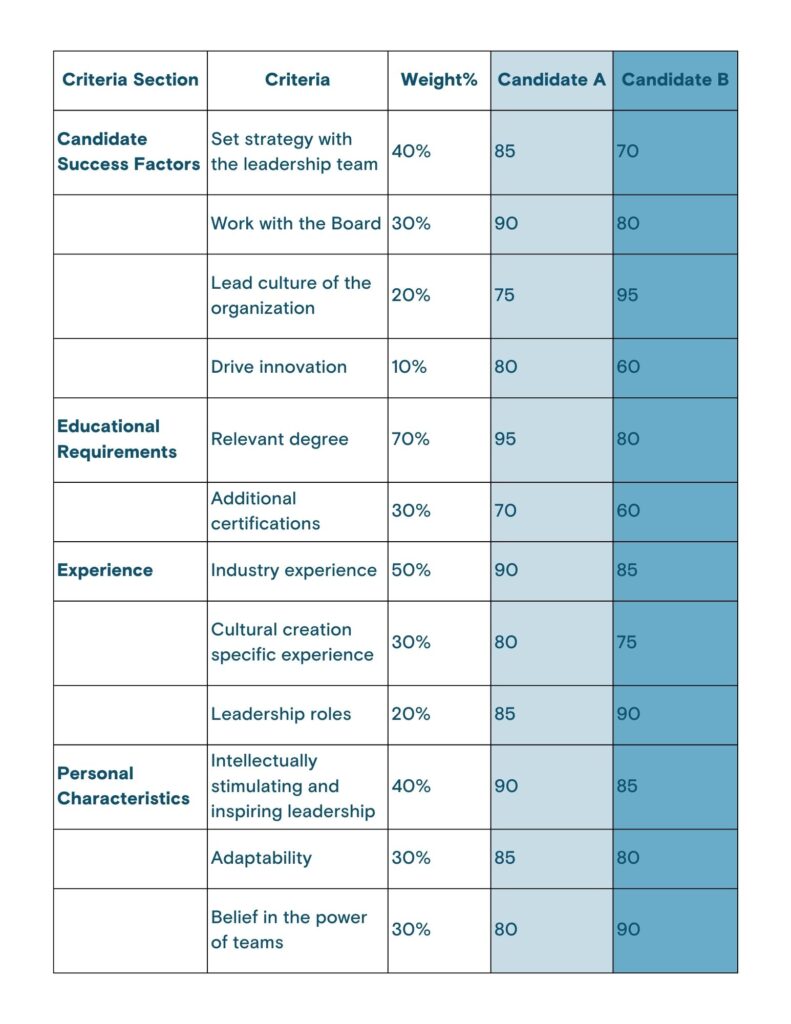As applications start rolling in, it’s essential to have robust screening processes in place to identify top candidates efficiently.
This may include resume reviews, pre-screening interviews, and skills assessments.
Be sure to tailor your screening process to the specific requirements of the role and use it as an opportunity to evaluate both qualifications and cultural fit.
Part 1: Establish Clear Criteria
Define the Candidate Success Factors
The first step is to break down the job description and assign levels of importance to its key components.
This will help you prioritize what you are looking for in a candidate.
Here’s how to do it:
1. Candidate Success Factors
Identify the critical success factors for the role.
These are the primary responsibilities and objectives that the candidate needs to achieve.
For example, for a CEO, success factors might include the ability to:
Assign a percentage out of 100 to each success factor based on its importance.
For example:
Ensure that the total equals 100%.
2. Educational Requirements
Evaluate how crucial the candidate’s educational background is for the role.
Assign a percentage out of 100 to reflect its importance.
This ensures you give proper weight to educational qualifications.
For example, if a relevant degree is vital for the job, you might assign:
Ensure that the total equals 100%.
3. Experience
Determine the type and level of experience required for the candidate to succeed in the role.
Assign a percentage to each type of experience based on its relevance.
This allows you to measure how well the candidate’s past experiences align with the job requirements.
For example:
Ensure that the total equals 100%.
4. Personal Characteristics
Identify the personal traits necessary for success in the role.
These might include leadership, adaptability, and teamwork.
Assign a percentage out of 100 to each characteristic.
For example:
Ensure that the total equals 100%.
Personal characteristics are often crucial as they can determine how well a candidate fits into your company culture.
Remember, people are often hired for their technical skills and fired for their personality, so don’t underestimate this section.
5. Assign Weight to Each Section
After assigning percentages to each subcategory (e.g., in Success Factors: set strategy with the leadership team, work with the Board, etc.), you will then need to add a percentage weight to each section itself.
For example, fit to:
Ensure that the total equals 100%.
Part 2: Prioritize and Rate Criteria
After establishing and assigning importance to the key criteria for the role, the next step is to list and prioritize these criteria within each section.
This structured approach ensures that you can evaluate candidates systematically and objectively.
Follow these steps:
1. List the Criteria in Priority Order: For each section (Candidate Success Factors, Educational Requirements, Experience, and Personal Characteristics), list the criteria you identified in Part 1 in order of importance.
2. Rate Each Candidate:For each criterion, rate each candidate on a scale of 1 to 100 based on how well they meet the criterion.

3. Calculation of Final Scores
To get the overall rating for each candidate, multiply the score they received for each criterion by the percentage weight of that criterion.
Equation: (% of criterion) x (Score of candidate) = X
Example Calculation for Candidate A (Success Factors section):
Total Score for Success Factors: 34 + 27 + 15 + 8 = 84/100
Calculate the scores for all sections
Do the same for Education, Experience, and Personal Characteristics.
Example Calculation for Candidate A:
Education:
Experience:
Personal Characteristics:
Personal Characteristics Total: 36 + 25.5 + 24 = 85.5/100
4. Aggregate the Total Scores by Section
Multiply each section’s total score by the weight you assigned to that section in Part 1 and then add them all together, giving you a score out of 100.
Equation: (Candidate’s score per section) x (Weight of section) = X
Example Calculation for Candidate A:
Total Rating for Candidate A: 38.475 + 29.4 + 17.2 + 8.75 = 93.825/100
Now, attempt to find the candidacy rating for Candidate B using the same method yourself.
Part 3: Pre-screening Candidates
Before inviting candidates for an in-depth interview, it’s crucial to conduct a thorough pre-screening process.
This step helps ensure that only the most qualified and suitable candidates proceed further, saving time and resources for both the hiring team and the candidates.
Here’s how to effectively pre-screen candidates:
1. Resume Review: Carefully examine each candidate’s resume to ensure they meet the basic qualifications and experience required for the role. Look for relevant skills, job history, education, and any specific achievements that align with the job description. Pay special attention to how their past roles reflect their values and approach to teamwork and leadership.
2. Initial Phone Screening: Conduct a brief and mindful phone interview to evaluate the candidate’s interest in the role and assess their perceived fit within the company. During this call, discuss:
By thoroughly and mindfully pre-screening candidates, you can effectively identify those who not only meet the job requirements but also resonate with the company’s vison, values, and action plans.
This step helps streamline the interview process and ensures a more aligned and purposeful hiring decision.
Blog written by Catherine R. Bell of The Awakened Company.